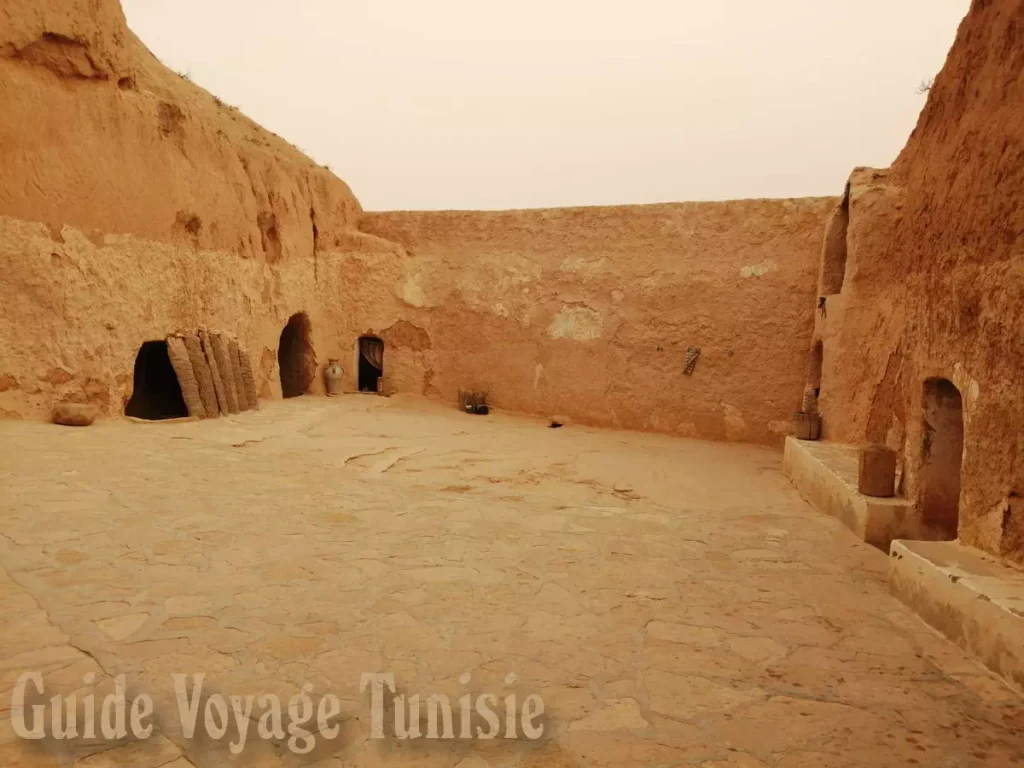The troglodyte houses
Troglodyte houses in Matmata are a unique form of architecture that dates back centuries (since Phoenician times) and are still inhabited by locals today. These houses are carved into the soft rock and cliffs of the Matmata region, creating a fascinating underground dwelling known for its distinct appearance and practical advantages.
Advantages of Troglodyte Houses in Matmata, Tunisia:
Natural Insulation: One of the significant advantages of troglodyte houses is their excellent natural insulation. The thick rock walls provide a stable indoor temperature, keeping the interiors cooler in the scorching summer heat and warmer during the chilly winter nights. This natural insulation reduces the need for artificial heating and cooling systems, making the houses energy-efficient and eco-friendly.
Protection from Harsh Climate: The Matmata region experiences extreme weather conditions, including intense heat and occasional sandstorms. The troglodyte houses’ underground structure shields inhabitants from these harsh elements, ensuring a more comfortable and safer living environment.
Preservation of Culture: Living in troglodyte houses is an integral part of the local culture and heritage in Matmata. These unique dwellings reflect the traditional way of life of the Berber communities in the region. By preserving and continuing to live in these houses, the inhabitants keep their cultural identity alive, passing down knowledge and skills from one generation to another.
Integration with the Landscape: Troglodyte houses blend harmoniously with the surrounding landscape. As the majority of the structure is carved into the rock, they do not significantly alter the natural beauty of the area. This integration with nature makes them visually appealing and environmentally sustainable.
Privacy and Security: The layout and design of troglodyte houses often include narrow entrances and interconnected rooms. This design offers a sense of privacy and security for the inhabitants. The underground nature of the houses also provides a certain level of protection from external threats.
Low Construction Costs: Building a troglodyte house is relatively cost-effective compared to traditional above-ground constructions. The main material, the rock, is readily available in the region, making it an affordable building resource.
Tourist Attraction: Matmata’s troglodyte houses have become a significant tourist attraction in Tunisia. Visitors are intrigued by the unique architecture and the chance to experience an alternative way of living. The tourism industry around these houses provides an economic opportunity for the local communities.
Despite the advantages, it’s essential to acknowledge that troglodyte houses may also present some challenges. Modernization and changing lifestyles have led some younger generations to prefer more conventional dwellings. Consequently, efforts to maintain and preserve these traditional houses are crucial to ensuring their continuity as an essential aspect of Matmata’s cultural heritage.
In conclusion, troglodyte houses in Matmata, Tunisia, offer numerous advantages, including natural insulation, protection from the elements, cultural preservation, integration with the landscape, privacy, and security, all while being cost-effective and attracting tourism to the region. These unique underground dwellings are a testament to the resourcefulness and adaptability of the local communities throughout history.
The troglodyte houses in pictures

